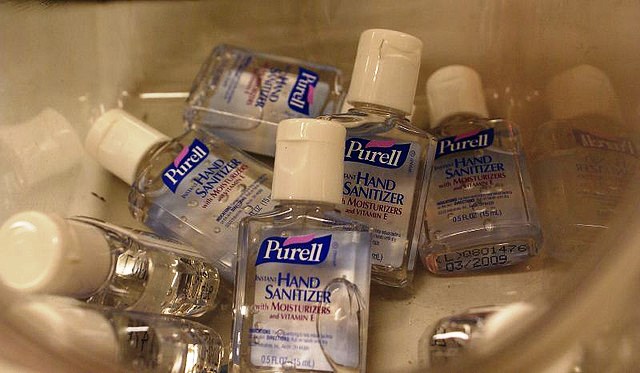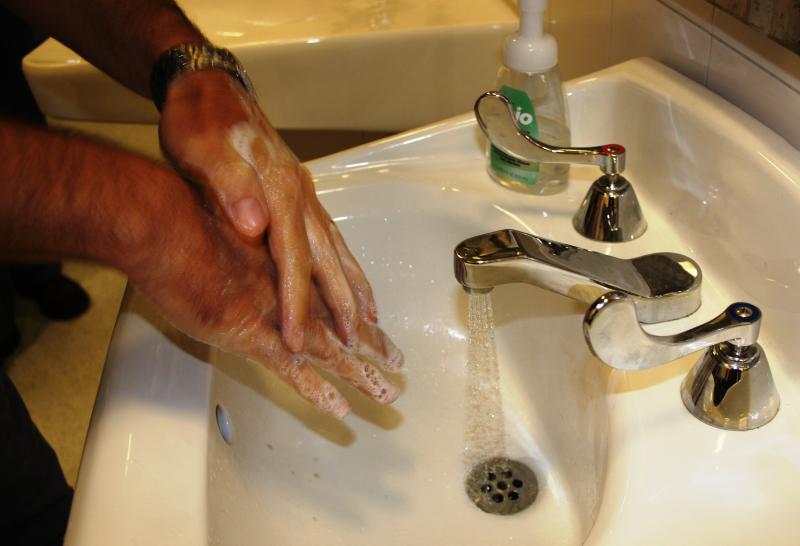Soap born in Akron's post-war grime
Gojo CEO Joe Kanfer worked at his uncle’s company long before he could drive. His job was to scavenge car parts for soap dispensers, like the one on display at the company’s Akron headquarters. The original Gojo formula was a thick cream that took a special dispensing device invented by his uncle Jerry Lippmann.
At the time, mechanics would often wash greasy hands with harsh solvents. In Akron’s machine shops, raw, red hands were the norm. Gojo co-founders Lippman and his wife Goldie saw an opportunity and experimented with soaps that could gently cut the grease. Kanfer says the breakthrough came after his uncle met Kent State chemist Clarence Cook.
“It was actually a development during World War II of non-ionic detergent that professor Cook at Kent State had been part of; it was to take flax off wool on Army uniforms.”
Goldie and Jerry – their names combined became Gojo – made the first batches in a basement washing machine and sold their new waterless hand soap door-to-door to Akron mechanics. Gojo rapidly grew into an iconic brand synonymous with Akron’s industrial grime.
A category-defining brand
Kanfer was 24 when he took over as CEO in the mid-70s; his daughter Marcella Kanfer Rolnick is vice-chair. She says Gojo’s history is marked by several ‘inflection points.’ She says first came the waterless soap, then innovative soap dispensers, "And then, when we brought Purell in, it rode the wave of us getting more and more into health care and other compliance markets. And now that’s where the next phase of our innovation and growth are coming from.”
 Gojo spent a more than decade building the Purell brand, then sold the consumer side of the product, only to buy it back in 2010. Kanfer won’t say what Purell’s worth to Gojo. Gojo spent a more than decade building the Purell brand, then sold the consumer side of the product, only to buy it back in 2010. Kanfer won’t say what Purell’s worth to Gojo.
But, Purell is a game changer. Like Vaseline, Kleenex, or Q-tips, Purell is a category-defining brand. Before Purell, Kanfer says doctors were told to wash with soap and water between every patient.
“That would have caused a nurse or doctor to wash 60 or 70 times a day, which you can just imagine is impossible.”
Now medical guidelines say alcohol-based sanitizers like Purell are the preferred method. Among consumers, health scares like the SARS outbreak, H1N1 and swine flu have made Purell synonymous with disease prevention.
Kanfer says, “If there were not Purell, if there were only soap and water, hand-washing compliance would be today impossible.”
The science of hand hygiene
In Gojo’s research lab, skin scientist Jim Arbogast demonstrates how surgeons wash their hands. He says in a surgical environment, proper hand washing is critical because the microorganisms that are left on your hands are at risk of entering the patient’s body.
Arbogast spends a lot of time washing his hands. He says there are several standard techniques for hand washing that aid his research, which he demonstrates in a number of Gojo's sample sinks.
But it’s what all this hand washing and sanitizing does to your skin that is Arbogast’s main focus. His lab has instruments that measure skin dryness, cracking, and redness. He says if you see a lot of redness on your skin, usually that’s a sign that it’s irritated, and, "often that’s associated with a bad feeling, tightness and stinging. We get all these data points, some objective, some subjective, and it helps us optimize our formulations.”
Arbogast shows me a mock-up of a hospital room complete with a dummy patient – and for about the 20th time, washes his hands. In the hospital suite Arbogast has installed half-a-dozen Purell dispensers, plus Purell wipes, gels and foams. Arbogast and his team are also developing dispensers equipped with monitors to detect how often healthcare workers use the product, and report hand-sanitizing compliance rates. All this cleanliness has me wondering whether we haven’t gone a little overboard in our war against germs.
He replies - “I hope some day we have that concern. Our main problem right now is the vast majority underutilizes hand hygiene. So our focus is more on trying to affect behaviors to get people to use it enough.”
And with 1.7 million hospital-acquired infections each year costing providers about $4 billion a year, it’s likely Gojo’s Purell will continue to define the new clean. |